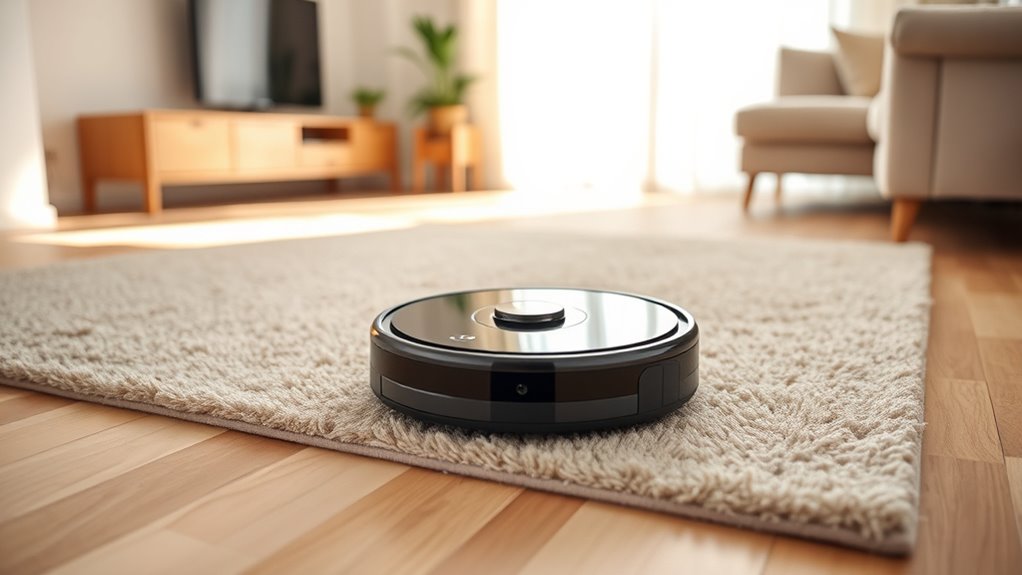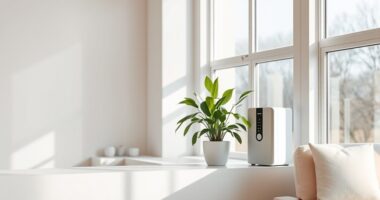To choose a robot vacuum, start by evaluating your cleaning needs and floor types. Look for models with strong suction, good navigation, and features suited for pet hair or allergens. Check battery life, quick recharging, and smart controls like app integration. Consider your budget and compatibility with your smart home. If you want to know more about finding the perfect match, you’ll discover useful tips that make the choice easier.
Key Takeaways
- Assess your surfaces and cleaning needs, prioritizing features like pet hair handling, allergen filters, and floor compatibility.
- Choose models with advanced navigation, mapping, and obstacle detection for efficient multi-floor cleaning.
- Consider battery life, charging time, and power management for uninterrupted, long-lasting cleaning sessions.
- Select devices with adjustable suction, cleaning modes, and smart app control for versatile, customized cleaning.
- Balance budget, compatibility with your smart home ecosystem, and read customer feedback to ensure overall performance and support.
Assess Your Cleaning Needs
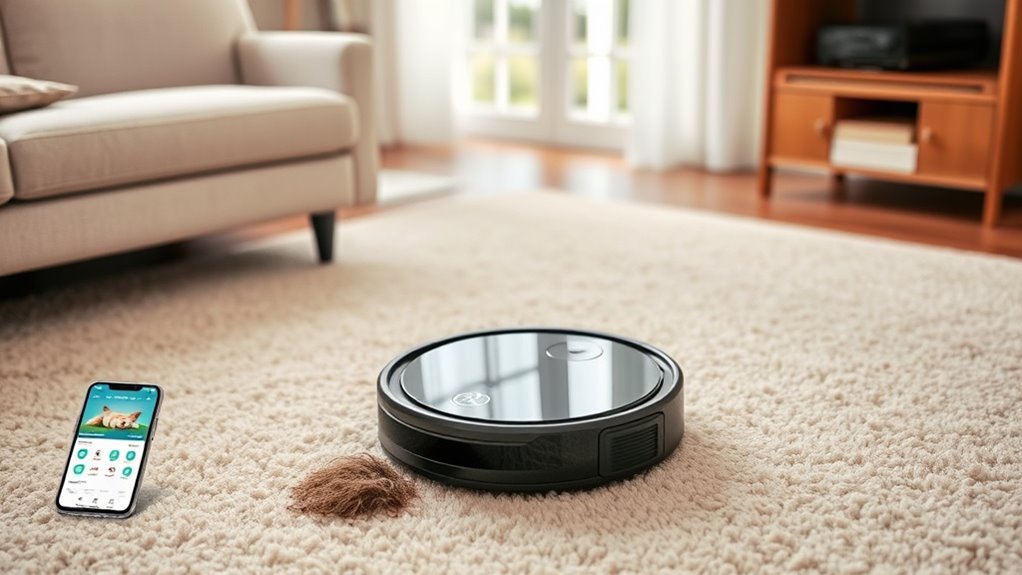
Before choosing a robot vacuum, it’s important to evaluate your cleaning needs. If you have pets, consider models specifically designed to handle pet hair, which can easily clog filters and brushes. Pet hair also tends to settle in corners and under furniture, so look for a vacuum with strong suction and good edge cleaning capabilities. If allergy concerns are a priority, select a robot with a HEPA filter that traps allergens and dust mites, improving air quality. Think about how often you need to clean and what surfaces you’ll be vacuuming, as this influences the features you should prioritize. By assessing your specific needs—whether dealing with pet hair or allergies—you can choose a device that simplifies your cleaning routine and keeps your home healthier. Additionally, choosing a model with air purification features can further enhance indoor air quality, especially in homes with allergy sufferers. Considering filter technology is also crucial to ensure optimal performance in capturing fine particles and maintaining air quality. Proper maintenance and sustainable practices can help prolong your vacuum’s lifespan and reduce environmental impact.
Consider Your Floor Types
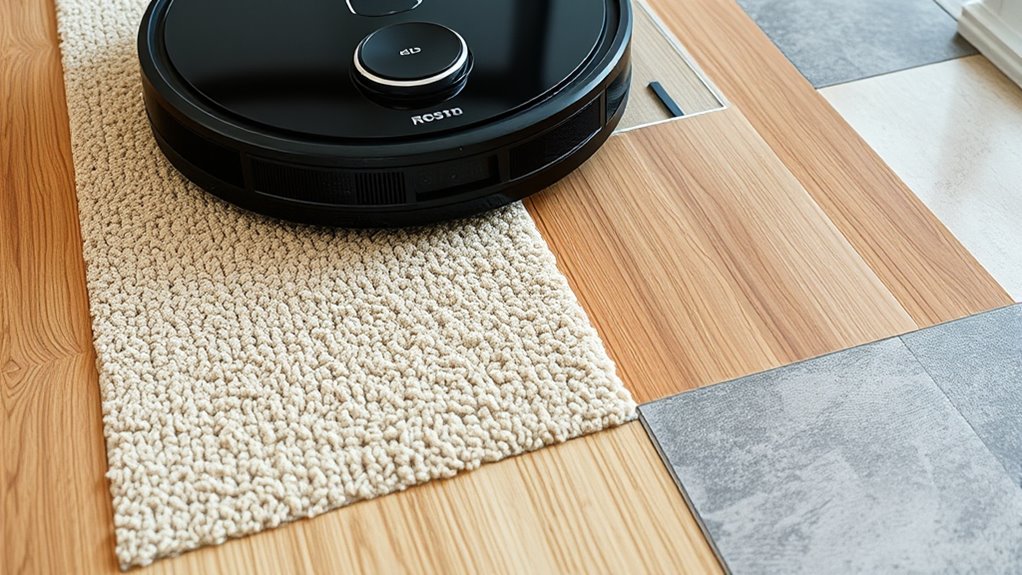
Your floors come in different types, and not all robot vacuums handle them equally well. Make sure the vacuum you choose is compatible with your surface, whether it’s hardwood, carpet, or tile. Also, consider how well it navigates across various floor levels to keep your entire home clean. To optimize cleaning efficiency, select a model with appropriate floor type compatibility and adjustable settings for different surfaces. Additionally, check the suction power to ensure it can effectively clean your specific floor type without causing damage or leaving debris behind. As with evolving AI capabilities, choosing a vacuum with advanced navigation can enhance its ability to adapt to complex floor layouts effectively, especially when managing multiple floor surfaces within the same space.
Floor Surface Compatibility
When selecting a robot vacuum, it’s crucial to consider your floor types, as not all models perform equally on every surface. Some vacuums excel on carpets with thick fibers, effectively removing dirt from deep within the fibers, while others are better suited for hardwood finishes, avoiding scratches and damage. Make certain your chosen model can handle the specific surfaces in your home to guarantee optimal cleaning. Additionally, consider automation in business and how the vacuum’s technology adapts to different environments for more effective cleaning. Verify compatibility with hardwood finishes to prevent damage and guarantee the vacuum can handle transitions between surfaces seamlessly.
Navigation on Different Floors
Since your home likely features multiple floor types, a robot vacuum must navigate shifts smoothly to clean effectively. Look for models with advanced obstacle detection, which help the vacuum identify and avoid furniture, rugs, and uneven surfaces on different floors. Multi-floor mapping is essential, allowing your robot to recognize and remember various levels in your home. This feature enables the vacuum to adjust cleaning patterns and avoid unnecessary repetitions or missed spots. A robot with smart navigation can seamlessly transition from hardwood to carpets and tiles, ensuring thorough cleaning without getting stuck. Additionally, choosing a model with Kia Tuning capabilities can enhance its adaptability and performance across diverse surfaces. Incorporating industry-leading technology ensures your vacuum adapts to your home’s layout, providing efficient, thorough cleaning across all floor types. Recognizing angel number patterns can also help you choose the right technology that aligns with your needs. To optimize performance, selecting a model with engine tuning features can further improve cleaning efficiency and surface adaptability.
Evaluate Battery Life and Charging Capabilities
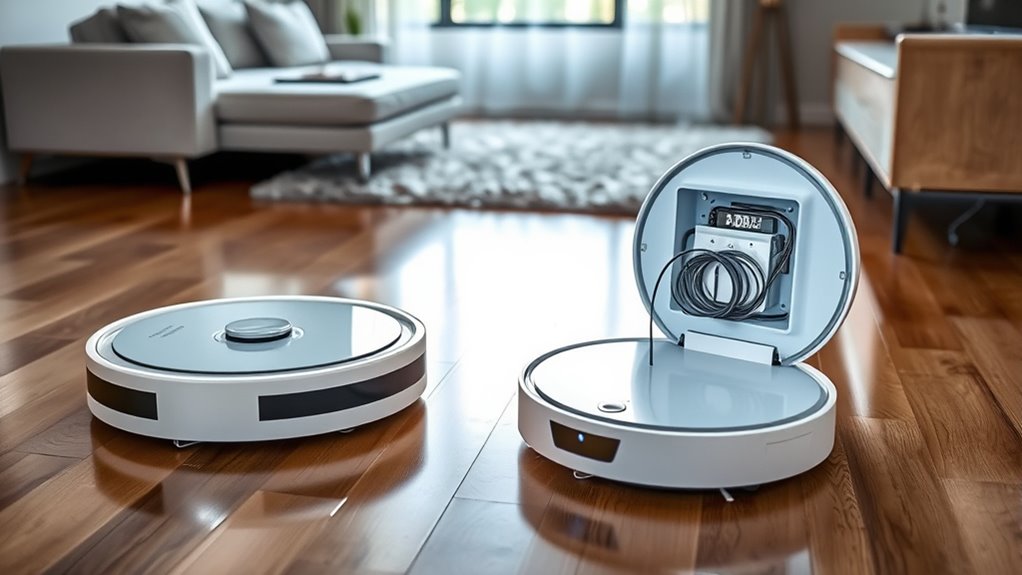
To keep your home clean without interruptions, you need a robot vacuum with solid battery life and efficient charging. Check how long it can run on a single charge, how quickly it recharges, and whether it has a convenient docking station. Also, consider if replacement batteries are easy to find in case you need them later. Additionally, look for models with smart capabilities like WiFi control and app integration, which can help monitor battery status and optimize cleaning schedules. Some models also feature automatic shutoff functions that conserve battery when cleaning is complete or if issues are detected. An understanding of battery technology can further inform your choice, ensuring longer-lasting performance and reliability. Moreover, evaluating power management features can enhance overall efficiency and battery longevity.
Battery Run Time
Battery run time is a crucial factor to contemplate because it determines how long your robot vacuum can clean on a single charge. Longer battery life means fewer interruptions and more efficient cleaning sessions. Look for models with higher battery capacity, which typically provide extended runtime. Keep in mind that frequent charging cycles can affect battery longevity, so choose a vacuum with durable batteries. Additionally, some models feature smart technology that optimizes power consumption for better battery performance. To optimize performance, reflect on:
- The advertised runtime per charge
- Battery capacity and how it impacts cleaning duration
- The number of charging cycles the battery can endure
- The ability to swap batteries for uninterrupted cleaning
Understanding battery maintenance can also help extend the lifespan of your vacuum’s power source. Moreover, selecting models with advanced battery management systems can further enhance overall battery health and longevity. A model with a long battery run time ensures thorough cleaning without frequent recharges, saving you time and effort. Proper battery charging practices are essential to maximize battery life and ensure consistent cleaning performance over time.
Charging Speed & Docking
Efficient charging speed and smart docking capabilities are essential for minimizing downtime and maintaining continuous cleaning. Look for robot vacuums with fast-charging features that quickly restore battery life so your device spends less time plugged in. A reliable docking station or charging stations should support seamless navigation, allowing your vacuum to locate and dock automatically when cleaning is complete or the battery is low. Some models offer rapid recharge times, ensuring minimal interruption between cleaning cycles. Additionally, a well-designed docking station should be stable and easy to access, making the charging process smooth. Prioritize these features to keep your robot vacuum ready for action, reducing the need for manual intervention and ensuring consistent, efficient cleaning performance. Regularly monitoring the battery level helps prevent unexpected shutdowns during cleaning sessions.
Battery Replacement Options
Evaluating a robot vacuum’s battery life and charging capabilities is crucial to guarantee it can handle your cleaning needs without frequent interruptions. When considering battery replacement options, focus on the battery technology used, as newer tech offers longer life and faster charging. Check the replacement procedures—some models allow easy swaps, while others may require professional service. It’s also useful to know the estimated lifespan of the battery to plan replacements proactively. Proper maintenance and understanding of the battery’s capacity help extend your vacuum’s performance. Keep an eye on these factors to confirm your device continues to operate efficiently. Battery technology advancements for longer-lasting power ensure your vacuum remains effective over time. Additionally, understanding GMC tuning principles can help optimize your device’s performance and longevity. Staying informed about celebrity lifestyle insights can also inspire innovative ways to enhance your home environment.
Examine Navigation and Mapping Features
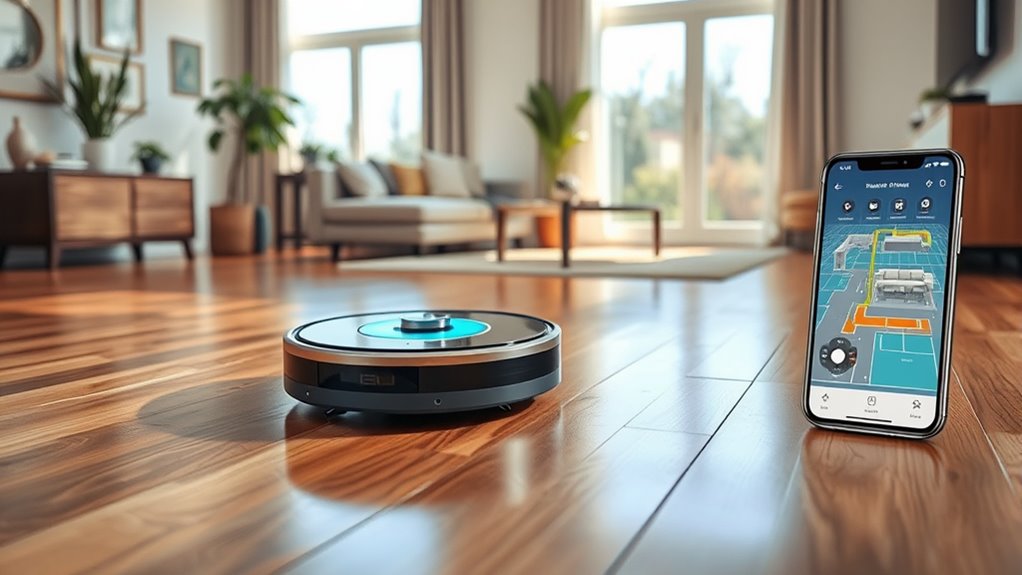
How well a robot vacuum navigates your space can make all the difference in cleaning performance. Look for models with strong mapping accuracy, so the device can create a precise layout of your home. This helps it cover every area efficiently without missing spots. Obstacle avoidance is equally important; a good robot detects furniture, cords, and other objects, preventing collisions and damage. Advanced sensors and cameras enhance these features, allowing the vacuum to adapt to different environments. A robot with reliable navigation can plan ideal cleaning routes, saving time and battery life. When evaluating options, test how well the vacuum recognizes and remembers obstacles and room layouts. This ensures thorough cleaning while minimizing the need for manual intervention or repeated passes. Additionally, security zone information can be used to customize cleaning areas and avoid sensitive or restricted spaces. Incorporating navigation technology into the selection process can significantly improve overall cleaning efficiency. Furthermore, mapping accuracy is crucial for ensuring the vacuum covers all designated areas comprehensively.
Review Suction Power and Cleaning Modes
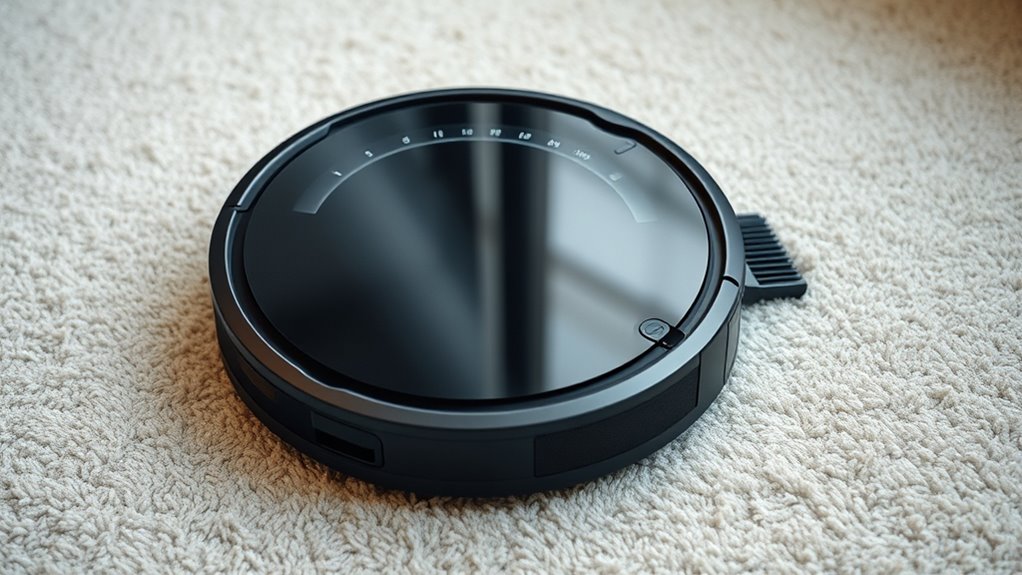
Since different cleaning tasks require varying levels of power, evaluating a robot vacuum’s suction capability is essential. A good suction power comparison helps you choose a model that effectively cleans your floors. Look for vacuums with multiple cleaning mode options, allowing you to customize cleaning intensity based on your needs.
Consider these key points:
- Check if the vacuum offers adjustable suction levels for different surfaces
- Review whether it has a boost mode for stubborn dirt
- Ensure there are specialized modes for carpets, hardwood, or tile
- Confirm if the vacuum can easily switch between modes for versatile cleaning
Think About Smart Technology and App Control
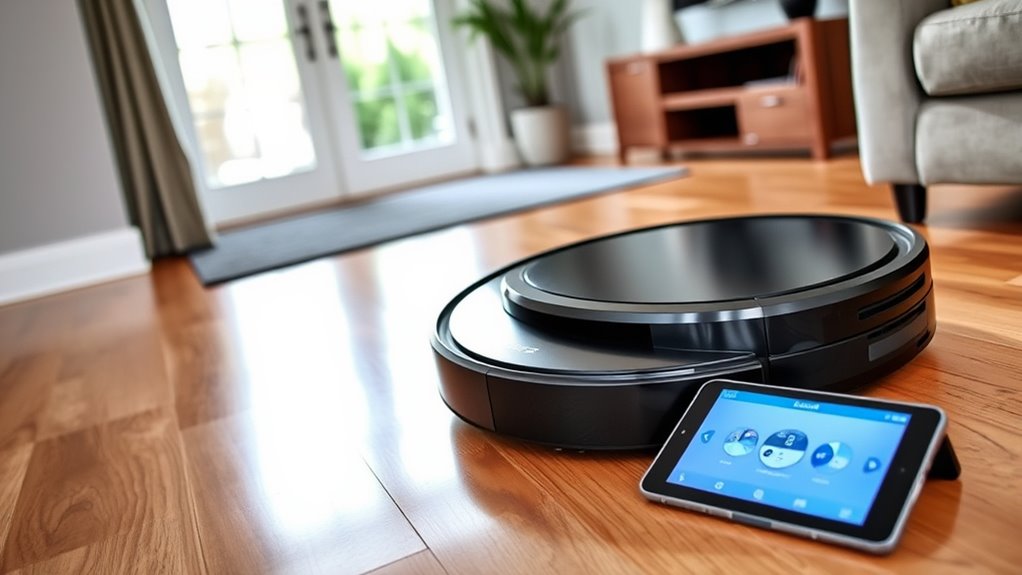
Smart technology and app control can considerably enhance your vacuuming experience by making it more convenient and efficient. With smart app control, you can start, stop, and monitor your robot vacuum from anywhere. Remote scheduling allows you to set cleaning times in advance, ensuring your floors stay tidy without manual intervention. Some models even learn your routine and adjust cleaning paths accordingly. Here’s a quick comparison:
| Feature | Benefits | Example Use Case |
|---|---|---|
| Smart app control | Control from smartphone or tablet | Start cleaning while at work |
| Remote scheduling | Set cleaning times remotely | Schedule nightly cleanings |
| Voice command support | Use voice assistants like Alexa | Initiate cleaning hands-free |
| Real-time alerts | Receive updates on cleaning status | Know when cleaning is complete |
Determine Budget and Cost-Effectiveness
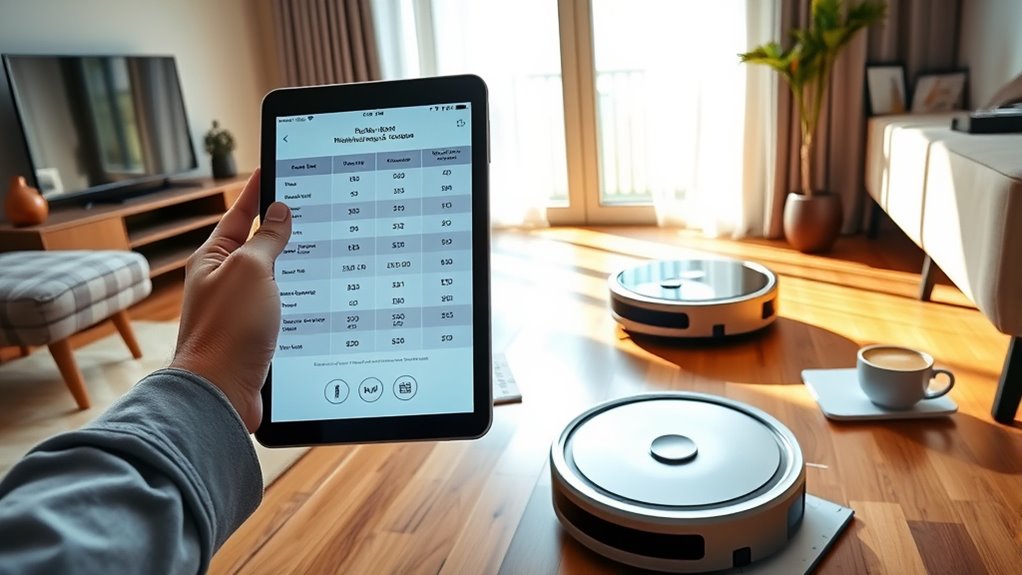
While smart technology and app control add convenience, it’s equally important to take into account your budget to ensure you’re investing wisely. Start by exploring different pricing strategies to find options that fit your financial plan. Consider the brand reputation—trusted brands often offer better durability and customer support, saving you money long-term. To maximize value, compare features against costs, and don’t forget to look for deals or discounts. Keep in mind that higher upfront costs may lead to better performance and reliability, reducing maintenance expenses. Remember, balancing your budget with the features you need will help you select a robot vacuum that delivers the best cost-effectiveness without overspending.
Check for Compatibility With Home Devices
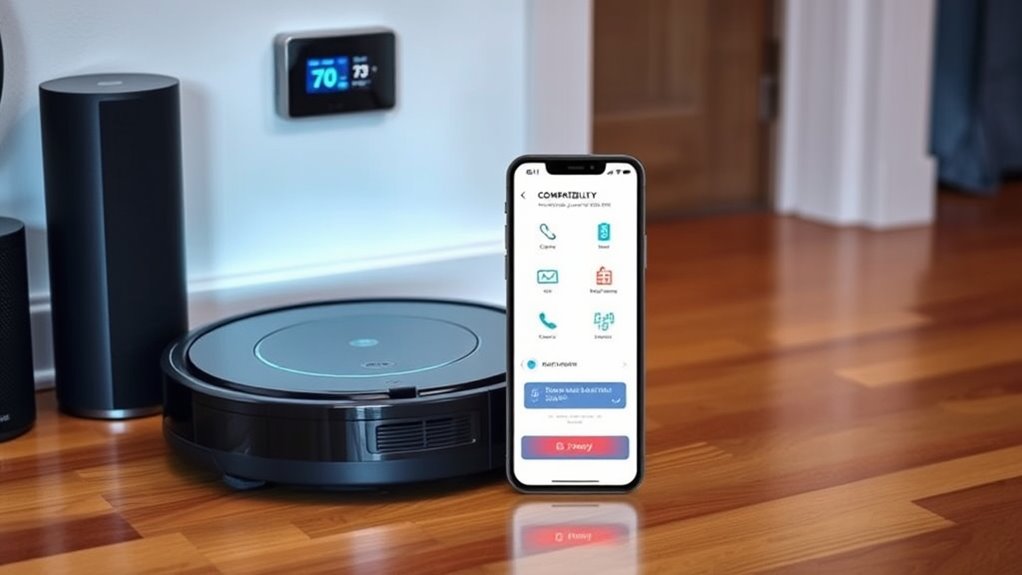
Ensuring your robot vacuum works seamlessly with your existing home devices can enhance convenience and streamline your cleaning routine. Check for smart home integration and device compatibility before purchasing. Many robot vacuums now connect with voice assistants like Alexa or Google Assistant, allowing you to start cleaning with a simple command. Compatibility with your smartphone app also enables remote control and scheduling. Use the table below to compare features:
| Feature | Compatibility Details |
|---|---|
| Voice Assistant Integration | Works with Alexa, Google Assistant |
| App Control | Compatible with iOS and Android |
| Smart Home Compatibility | Syncs with smart home ecosystems |
Verifying these features guarantees your new robot vacuum fits seamlessly into your smart home setup.
Read Customer Reviews and Ratings
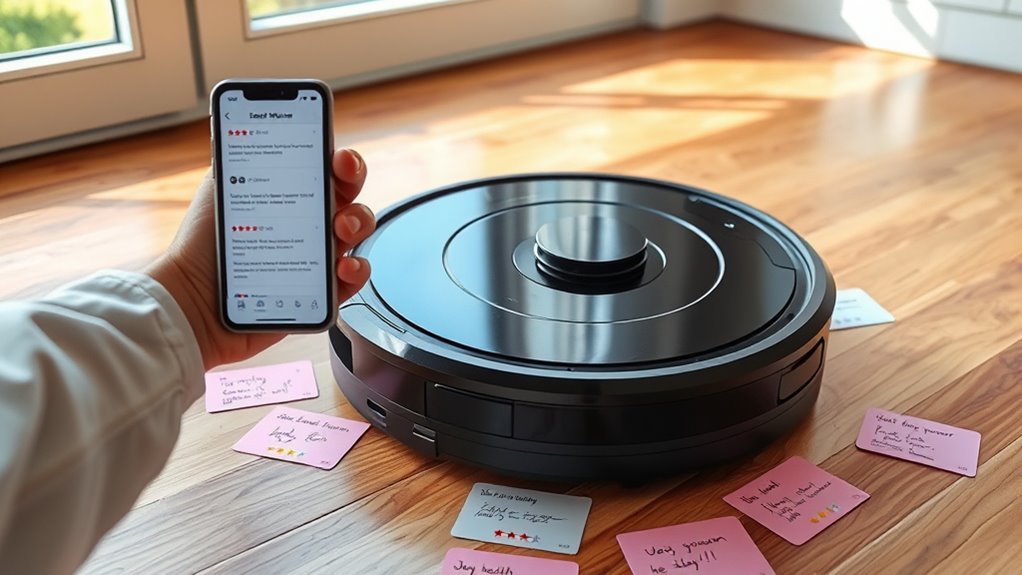
After confirming your robot vacuum’s compatibility with your home devices, it’s important to see how it performs in real-world situations. Reading customer reviews and ratings gives you valuable insight into its reliability and efficiency. Pay attention to customer feedback about cleaning performance, battery life, and ease of use. User ratings can reveal common issues or standout features you might not find in specs alone.
- Look for reviews from users with similar flooring and household size
- Check for consistent praise or complaints about navigation
- Note if the vacuum handles pet hair or allergies well
- Consider feedback on customer service and warranty support
Customer feedback helps you gauge real-world durability, while user ratings highlight overall satisfaction. Use this info to make a smarter, informed choice.
Frequently Asked Questions
How Often Should I Replace the Robot Vacuum Filters?
You should replace your robot vacuum filters based on the filter maintenance and the replacement schedule recommended by the manufacturer. Typically, filters need changing every 2-3 months with regular use, but this can vary depending on your home’s dust levels and your vacuum’s usage. Keep an eye on the filter’s condition; if it looks clogged or discolored, it’s time for a replacement to guarantee maximum cleaning performance.
Can Robot Vacuums Handle Pet Hair Effectively?
Think of your robot vacuum as a loyal dog, keen to clean up pet hair and keep your home fresh. It handles pet hair effectively, especially on carpets, thanks to powerful suction and specialized brushes. You can rely on it for consistent carpet cleaning, capturing even stubborn fur. Just make certain it has a good filter, and you’ll enjoy a fur-free home without lifting a finger.
Are Robot Vacuums Suitable for Allergy Sufferers?
If you have allergy concerns, robot vacuums can help, but only if you choose models with good vacuum allergen filters. These filters trap dust, pet dander, and other allergens effectively. Regularly emptying the bin and maintaining the filters also reduces allergen buildup. While they can make your space cleaner, verify the robot vacuum is designed for allergy sufferers to truly improve your indoor air quality.
What Warranty Options Are Available for Robot Vacuums?
Imagine your robot vacuum as a loyal guardian in your home. Warranty coverage offers peace of mind, like a shield protecting it from unforeseen troubles. Many brands include repair services and extended warranties, so you’re covered if it falters. Look for options that match your needs, ensuring your cleaning companion stays sharp and reliable. With the right warranty, you can trust your robot vacuum to serve you worry-free, season after season.
How Noisy Are Different Robot Vacuum Models During Operation?
When considering noise levels, you’ll find that robot vacuums vary in decibel comparisons. Some models operate quietly around 55-65 decibels, similar to a normal conversation, while others can reach 70-75 decibels, comparable to background noise. If noise is a concern, look for models specifically designed for quiet operation. You’ll appreciate how quieter models make vacuuming less disruptive, especially if you have pets or work from home.
Conclusion
By evaluating your needs, considering your floors, analyzing battery life, examining navigation, reviewing suction power, thinking about smart features, determining your budget, checking compatibility, and reading reviews, you’ll make an informed choice. With clarity and confidence, you’ll select a robot vacuum that fits your home, meets your expectations, and simplifies your cleaning routine. Ultimately, choosing the right robot vacuum means choosing convenience, efficiency, and peace of mind—making your home cleaner, smarter, and more enjoyable every day.
